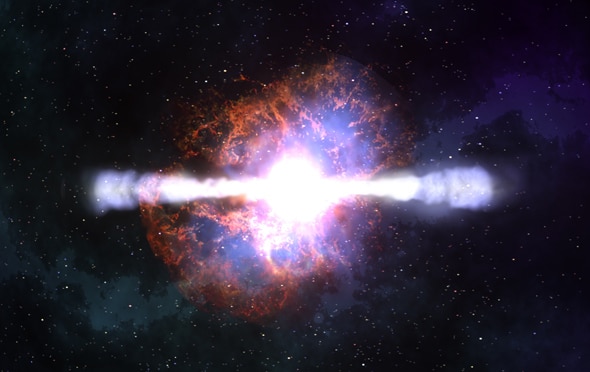Create a free profile to get unlimited access to exclusive videos, sweepstakes, and more!
Crash Course Astronomy: Gamma-Ray Bursts

Back when I got my Ph.D. in astronomy, I was pretty focused on my own research topic. Still, I grew up loving astronomy, and I never lost the bug to learn about different aspects of it. For my degree I was studying an exploding star and had always been fascinated by apocalyptically huge explosions in space.
Thinking back on those days, I’m surprised I didn’t seem to know that much about gamma-ray bursts. These huge explosions in space are basically genetically designed to hit all my scientific sweet spots: They’re mysterious, they’re ridiculously powerful, everything about them is over the top, and they baffled astronomers for decades.
I’m not sure why I didn’t read much about them then, but that sure changed! They’re one of the most amazing kinds of events the Universe can muster these days. Even better? They’re the topic of this week’s Crash Course Astronomy:
I never did any scientific research on GRBs, but I’ve been involved with them for a while now. When I was working on Hubble I started getting really interested in them; I remember impatiently waiting on the data from observations of GRB 990123 taken by the camera I was working on. As soon as we got them, I pounced, processing them and creating an image of the explosion. I was stunned to see it sitting right on top of an odd, curved-V-shaped galaxy, clearly the host of the burst. Literally at the same time, my colleague Andy Fruchter (who did in fact study GRBs and was in charge of these Hubble observations) was also processing them, and he was the one to make the important announcement that the camera had clearly detected the host galaxy. It was extremely cool to have seen that data right as it came off the ‘scope.
Then, a few years later, I worked on the education and public outreach programs for observatories like Swift, Fermi, and others. These would also play a crucial role in detecting and characterizing GRBs (as I mention in the video).
I wound up writing a whole chapter about GRBs in my book Death From the Skies! In fact, I spent more time on that chapter than any of the others, reading a huge number of research journal papers on how a pulse of high-energy X- and gamma rays from a relatively nearby GRB would affect our atmosphere.
This is a field of ongoing work, and it’s fascinating. The papers I read were all over the place, some predicting very bad things from a nearby GRB, others not so bad (all depending on the distance, of course). True story: The papers that concluded we’d be OK I marked with smiley faces on top, and frownies for the ones where we fared not so well. It was the best way for me to delineate the two stacks.
After reading all that research, the one thing I can be sure about: As tantalizing as these objects are to study, I’m really glad they’re really far away.


























